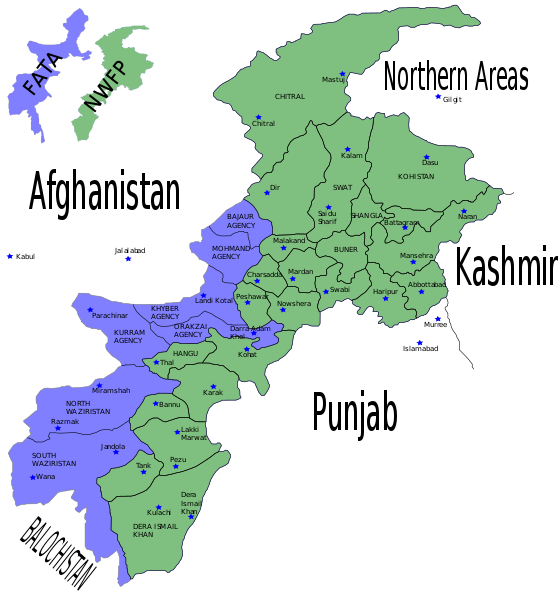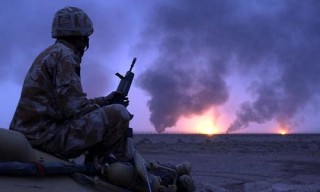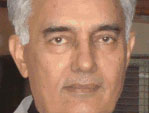By Brig Asif Haroon Raja
THE SO CALLED WAR ON TERROR HAS CREATED MORE TERROR THAN THE SUPPOSEDLY TERRORISTS
Pak Army troops and the militants in north-western tribal belt are locked in mortal combat since 2003. Both sides have been bleeding each other but refusing to give up. While the Army has lost 2955 officers and men, the losses of militants are as much of not more. Both enjoy some tactical advantages and also suffer from certain handicaps. In terms of armaments, both sides are well stocked and laced with sophisticated weaponry and communication system to fight a long drawn protracted war of attrition. Material and monetary needs of Tehrik-e-Taliban Pakistan (TTP) are met by CIA and RAW. Rough terrain, inclement weather and hit and run tactics compensate for militants inferiority in numerical strength and absence of tanks, artillery, choppers and air.
These hazards are overcome by avoiding positional and pitched battles and making use of caves and tunnels in the mountains. Supply routes through porous Pak-Afghan border and safe havens in Afghanistan are other advantages enjoyed by TTP. Its linkage with several banned extremist groups based in major cities and with Al-Qaeda adds to its strength. Security forces lacking in guerrilla warfare training and counter terrorism equipment found it difficult to fight the faceless enemy. Another serious handicap was the constraint of collateral damage since the fight was with misled Pakistanis. Last but not least, the Army had to all along remain mindful of its wicked enemy on the eastern border as well as enemies in guise of friends in Kabul, continuously stabbing Pakistan in the back.

Valour, steadfastness to keep fighting and spirit of camaraderie are in abundance on both sides. Both are convinced that they are fighting for the right cause. It is a clash of titans and battle of nerves between the brave hearts, each side trying to outwit the other. Both made gains and also suffered reverses but recovered after inking peace deals and again crossed swords with even greater vigour and enthusiasm.
This matching contest continued till as late as February 2009 when peace deal was signed in Swat. By that time the security forces had overcome most of their shortfalls and were fully motivated and battle inoculated. Double game of the so-called friends had become evident in mid 2007.
One year of mission oriented low intensity conflict training from January 2008 onwards together with handsome welfare package for the troops helped in raising their fighting proficiency and morale. Above all, public support turned in favour of the Army after Fazlullah led militants dishonoured the treaty and their hidden intentions got exposed.
The finesse which the Army applied in the critical battle of Malakand and Swat against heavily fortified positions of Fazlullah led militants began to swing the tide in favour of the Army. Rapid successes achieved in Swat received a quantum jump in the mother of battles fought in South Waziristan (SW) where to the utter surprise of many the Army demolished strongholds of TTP at Kotkai, Srarogha, Shrangrawari, Kunigram, Ladha and Makeen. Speed and intensity of three pincers upturned the well laid network and forced the militants to flee. Air force and choppers played their respective parts professionally to avoid collateral damage.
Loss of main operational bases of Swat and SW deprived the militant commanders the ability to put up organized resistance. It forced them to activate smaller bases in Bajaur, Mohmand, Khyber, Orakzai and Kurram Agencies with a view to break the momentum of offensive in SW. Series of suicide attacks combined with terrorist attacks were unleashed in major cities to affect recoil and to force the leadership to seek peace.
Since the Frontier Corps had already been positioned and tasked to deal with militants in likely restive areas and its strength was buttressed with army units, helicopter and air support wherever required, the militants could not gain advantage in any of the trouble spots. Offensive posture adopted by the Army units on all fronts gave the militants no respite to regroup and thus enabled the Army to wrest initiative. People weathered the terror attacks with fortitude.
Though the TTP is in disarray and there is leadership crisis, it is certainly not a spent force and is capable of launching small scale attacks and suicide attacks for quite some time till they expend their stocks and exhaust funds. TTP members have however begun to respect and admire the tenacity and fighting skills of soldiers and now call them as ‘Faujis’ instead of ‘hypocrites’. The people of Swat and Malakand Division have started loving the Army after having seen their real humanitarian face.
Till the deadly attack carried out by a Jordanian on US base in Khost in which seven CIA agents were killed and six got injured, the wrath of drones fell on areas influenced by Gul Bahadur and Sirajuddin Haqqani in North Waziristan (NW), both believed to be aiding insurgency in Afghanistan. The incident infuriated CIA so intensely that in revenge it accelerated drone attacks on suspected targets in NW. CIA operated drones then began to target fugitive Hakimullah Mehsud since he was seen in a video tape with suicide bomber Balawi. Although Hakimullah played no role in the attack, two to three attempts have already been made on him. Last one was on 14 January in which it was widely believed that he was killed. It is still a mystery whether he is dead or alive since TTP spokesman still maintains that he is alive while the US is reluctant to confirm.
This is one way to build the image of a runaway in the eyes of locals of Waziristan since those in bad books of America are heroes in the books of tribesmen. This may have become necessary in the light of unearthing of huge dumps of Indian made armaments from his strongholds thereby establishing his links with RAW and CIA. Other reasons could be that besides his possible connection with Balawi, USA must be unhappy with his performance. He gave up his main bases fortified over a long period too easily and cheaply thereby not only jeopardizing the position of India and America but also making the position of Pakistan strong. Another reason of targeting Hakimullah could be to prove to Pakistan that it is following an even handed policy in two parts of Waziristan.
Despite Pakistan’s loud protests the US continues to maintain that drones are an effective tool to stabilize Afghanistan and would not be discontinued. US leaders fail to realize that this highly inaccurate weapon system kills 98% innocent people and only 1% actual suspects. The average so far is one militant out of 100 innocent civilians killed. They fail to comprehend that drones are further radicalizing the people of FATA, fuelling anti-Americanism, jeopardizing the position of Pakistan government and impelling peace loving citizens to pick up arms and join hands with Taliban. What should one expect from the survivors of a family cut to pieces by hellfire missiles?
Downing of one drone by militants in NW has triggered retaliatory revengeful drone attacks. NW is virtually under siege of CIA operated drone onslaughts. Deadliest attack was on 02 February in which 18 missiles were fired killing 32 people mostly innocent civilians. In one of the attacks Jalaluddin Haqqani’s son has been killed. Drone attacks have purposely been intensified to provoke the militants and the people in NW to confront the Army thereby compelling the latter to launch a full fledged operation and thus get further stretched.
The US military has got locked on to NW since it strongly believes that Osama as well as top leadership of Al-Qaeda is based in this region and that they are busy planning another 9/11 like attack on US homeland. All civil and military leaders of USA, Obama downwards have expressed fears about FATA. US military operating in Afghanistan hold FATA based Al-Qaeda and Taliban duly supported by Pakistan responsible for its dismal performance. Top US military leadership is convinced that unless the bases in FATA are dismantled, no progress can be made in Afghanistan. In other words they have linked their success in Afghanistan to the progress achieved against Al-Qaeda and Taliban in FATA. Now that SW has been taken over by Pak Army, the US wants the operation to be extended to NW.
If Al-Qaeda is supported by the ISI and Army, why these two institutions captured over 600 Al-Qaeda operatives including high value targets and handed them over to USA; and why so many terror attacks on these institutions? Likewise, if there is covert link between the ISI and Afghan Taliban, why several Taliban leaders have been arrested in the recent past and that too at a time when US military in Afghanistan is in dire trouble and contemplating early withdrawal and the Taliban have gained an upper hand? This theme suits US military to cover up its failures.
Having assessed the fighting potential, resolve and tenacity of the militants, their misdirected potentials should be diverted towards constructive channels by way of inducting them as regular soldiers in newly named Tribal Light Infantry Battalions similar to the initial status given to NLI.
Afghan National Army being overwhelmingly non-Pashtun and US trained is seen as a US mercenary army and has no credibility in the eyes of Afghan Pashtuns. Efforts to bolster its strength and fighting capacity would go waste until and unless the demographic balance is not corrected.
 Obama has not wilted under public pressure to announce gradual reduction of US troops from Afghanistan from mid July 2011 onwards and to enter into negotiations with Taliban for a negotiated political settlement. Poor military showing against resurgent Taliban together with worsening economic health are the two over riding factors behind his decision. Having already spent $1.075 trillion on war on terror and with $1.7 trillion budget deficit and debt likely to rise to $20 trillion by 2015, and with little hope of recovery both on military and economic planes, the US can ill afford to continue with expensive and senseless war.
Obama has not wilted under public pressure to announce gradual reduction of US troops from Afghanistan from mid July 2011 onwards and to enter into negotiations with Taliban for a negotiated political settlement. Poor military showing against resurgent Taliban together with worsening economic health are the two over riding factors behind his decision. Having already spent $1.075 trillion on war on terror and with $1.7 trillion budget deficit and debt likely to rise to $20 trillion by 2015, and with little hope of recovery both on military and economic planes, the US can ill afford to continue with expensive and senseless war.
Pakistan should insist on stoppage of drone attacks; immediate closure of Pak specific Indian consulates in Afghanistan and end to covert operations. The US should be advised that to make proposed reconciliation productive, negotiations with Taliban should not be selective and conditional; and policy of dividing Pashtuns and pitching one against the other may prove counter productive and result in another round of internecine war once the foreign forces depart.
Brig Asif Haroon Raja is a Member Board of Advisors, Opinion Maker. He is a defence analyst who has written five books.

After graduating from college, I joined Pakistan Army and was commissioned in a Tank Regiment. I am a veteran of the Indo-Pakistan war. After leaving the Army, I joined IT as a profession. I was hired by Kuwait Air Force And Air Defence as an Adviser to computerize its entire operation. Here I was the Chief Coordinator of the Project, Kuwait Automated Support System (KASS). It was a state-of-the-art leading-edge technology where we established over 500 online terminals network with dedicated voice and data communications. It had Satellite linkups to connect with other systems and track the inventory movement for KAF & AD. On this project, I was coordinating with the US Navy, IBM World, AT&T, and Martin Marietta for the development, deployment, and operation of the KASS. Writing has always been a passion for me, been writing for 25 years for various newspapers and periodicals. Now for the last four years, I have formed my virtual Think Tank, Opinion Maker. Here we have some renowned writers from Pakistan and abroad who contribute regularly that’s helping the world opinion in some way. I am a keen golfer may not be a good one but play on a daily basis. I am also fond of using the camera to picture nature and people.
ATTENTION READERS
We See The World From All Sides and Want YOU To Be Fully InformedIn fact, intentional disinformation is a disgraceful scourge in media today. So to assuage any possible errant incorrect information posted herein, we strongly encourage you to seek corroboration from other non-VT sources before forming an educated opinion.
About VT - Policies & Disclosures - Comment Policy



